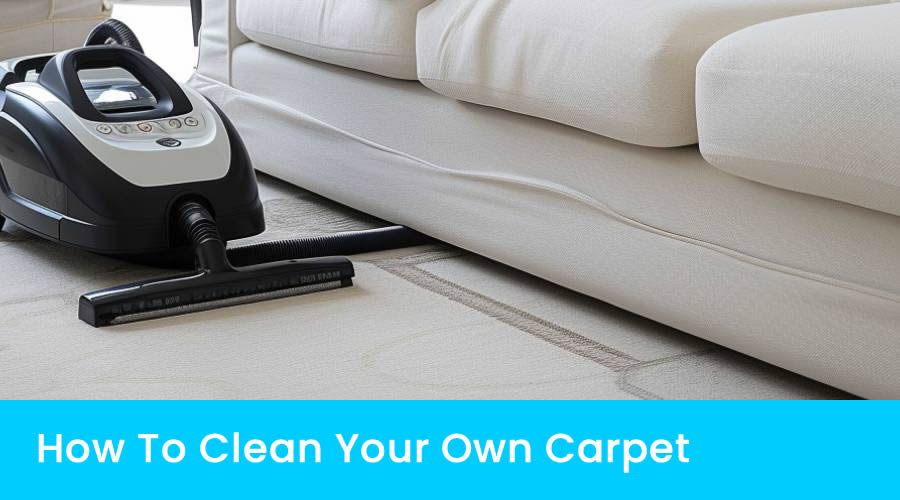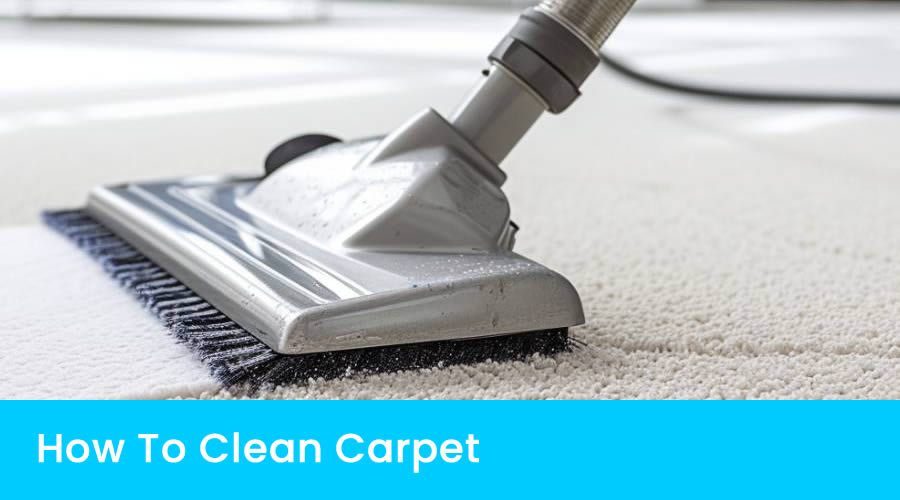How To Clean Your Own Carpet
Carpets absorb dirt, dust, and bacteria every day. They also trap allergens, stains, and odours. Without regular cleaning, fibres become dull and worn. Professional cleaning is effective but often expensive. You can achieve strong results at home with simple steps and safe products.
This guide explains how to prepare, treat carpet stains, and deep clean using safe solutions.
Tools and Materials
- Vacuum with strong suction (HEPA preferred).
- Buckets or spray bottles.
- Microfiber cloths and a soft bristle brush.
- Fans, air conditioner, or dehumidifier.
- Optional: wet/dry vacuum, steam cleaner rental, carpet shampooer.
- Optional: enzyme cleaner for pet urine.
Carpet Cleaning Process: Step by Step Guide
1. Preparation
Remove small objects and rugs. Move furniture you can lift safely; use sliders or pads to avoid drag marks. Protect legs with plastic or foil if they must remain on damp carpet. Then vacuum thoroughly. Two slow passes in each direction work better than one quick pass. Use edge tools for skirting boards and corners. Dry soil removal is essential; it prevents mudding when moisture is applied.
2. Patch test
Select an inconspicuous area. Apply a small amount of cleaner. Wait 10 minutes. Blot with a white cloth. Check for dye bleed, fibre distortion, and residue. If the test is clear, continue. If not, switch to a pH-neutral, wool-safe detergent.
3. Mix a mild solution
Prepare this base formula: warm water, a teaspoon of dish soap, and a splash of vinegar. Place it in a spray bottle or bucket. Use a mild carpet cleaning solution; avoid bleach, ammonia, or high-alkaline products. Keep dilution gentle to reduce sticky residue and re-soiling. Do not mix chemicals.
4. Spot treatment
Work one stain at a time. Start with dry blotting to lift excess. Apply a small amount of solution. Agitate lightly with a soft brush, moving from the edge toward the centre.
- Food and drink spills: repeat light applications until no transfer occurs.
- Grease and makeup: dish soap assists emulsification; use sparingly.
- Pet stains: after the mild solution, use an enzyme cleaner to break down odour-causing compounds.
Blot again with a dry cloth. Do not scrub. Do not flood the pad.
5. Deodorise with baking soda
Apply a Baking soda carpet cleaner on dry fibres for general odour control. Allow 30–60 minutes of contact time. Vacuum thoroughly. For heavy odours, leave it overnight, then vacuum again. This step supports odour removal without fragrance or solvents.
6. Full-area cleaning
Choose manual cleaning or a machine method. The goal is controlled moisture and consistent extraction.
Manual method. Work in small sections. Lightly mist the solution. Brush with short strokes to lift soil from the pile. Blot with dry microfiber until minimal moisture remains. Repeat section by section. Rinse by misting plain water, then blot again. This reduces surfactant residue and keeps fibres cleaner for longer.
Machine method (steam cleaner or carpet shampooer). Fill the tank with water only, or with a mild, low-foaming detergent per the manufacturer. Make slow forward passes to apply, and slow backward passes to extract. Add two extra dry passes for each lane. Avoid heavy soap loads; residue accelerates re-soiling and dulls the pile. Hot water extraction improves soil removal, but monitor temperature on wool and solution-dyed fibres.
7. Rinse
After cleaning, perform a clear-water pass (machine) or a light mist of plain warm water (manual). Blot thoroughly. Rinsing reduces stickiness and improves long-term appearance. Skipping this step often leads to rapid soil return.
8. Drying
Accelerate airflow immediately. Open windows if outdoor humidity is low; otherwise, use AC or a dehumidifier. Angle fans to move air across the surface, not straight down. Keep traffic off the carpet until fully dry. Target a 6–12 hour dry time depending on pile depth, ventilation, and ambient humidity. Slow drying can cause odours and wicking.
When dry, vacuum again. This lifts the pile, removes loosened particles, and restores uniform texture.
Common errors
- Too much detergent. Sticky residue attracts soil.
- Too much water. Saturation drives soil deeper and slows drying.
- Aggressive scrubbing. Fibres distort and stains spread.
- Skipping the patch test. Risk increases on wool and dark dyes.
- Chemical mixing. Never combine white vinegar with bleach or ammonia.
Maintenance schedule
Vacuum high-traffic areas twice weekly; other zones at least weekly. Use entrance mats inside and outside. Enforce a shoes-off policy for carpeted rooms. Treat spills immediately; fresh stains release faster and with less chemical load.
Plan a DIY deep clean every 3–4 months for busy homes and every 6 months for low-traffic spaces. Book professional hot water extraction every 12–18 months or per warranty requirements.
Quick checklist to deep clean carpet at home
- Prepare the area. Clear items; Move furniture where feasible.
- Vacuum thoroughly. Cross-hatch passes.
- Mix mild solution. Warm water, a teaspoon of dish soap, and a splash of vinegar.
- Spot clean. Blot, apply, agitate gently, blot again.
- Clean sections. Minimal moisture; slow, even passes.
- Rinse. Clear-water pass or light mist.
- Dry fast. Ventilation and dehumidification.
- Final vacuum. Lift pile and remove residue.
Follow these steps and keep solutions mild and passes slow. You will achieve stable, repeatable results with lower risk to carpet fibres and indoor air quality.


